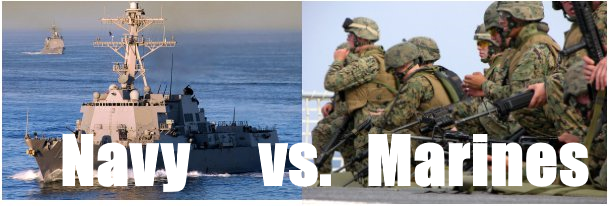Many people who research the different branches of the military wonder about the differences between Navy vs. Marines.
While both of these branches of the United States Armed Forces fall under the Department of the Navy and complement one another, they do have key differences.
In some cases, the differences are small while in other cases the differences are vast.
Related Article – Army vs. Marines
Table of Contents
Navy vs. Marines: What is the US Navy?
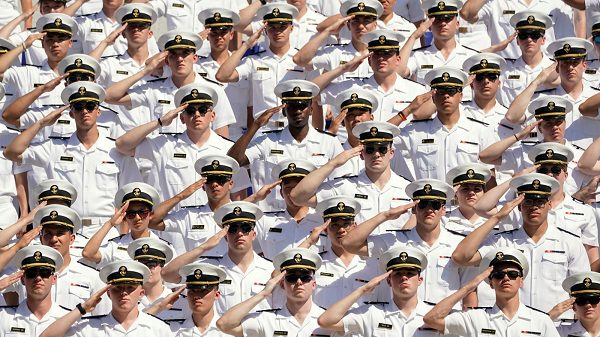
The Navy goes way back to the Revolutionary War and has its roots in the Continental Army.
America took a lot of damage and loss of supplies because of pirates during the Revolutionary War, so congress decided to build ships and pass the Navy Act of 1794.
By the time of the Civil War and going forward, the Navy has played a substantial role in mission success.
Today, the Navy is global and ready for a crisis.
Also, the Navy deploys during times of peace to build relationships with foreign allies.
What is the Navy’s Responsibility?
The Navy has three sets of responsibilities.
First, the Navy must ensure Naval forces are ready and prepared for missions.
Next, the Navy must maintain its aviation abilities because even though the Navy is a maritime branch of the military, they also deal with all aviation aspects both at sea and on land.
Finally, the Navy works to develop weapons, techniques, and aircraft to ensure technology and ability are current.
What is the Navy’s Mission?
The Department of the Navy has a clear mission to have combat-ready troops to win wars, deter aggressors, and maintain freedom of the seas.
Also, having service members equipped and organized is necessary to win wars and ensure our country is secure.
What is the Navy’s Size?
The Navy has approximately 347,000 sailors on active duty and over 110,000 in the Navy reserves.
However, it is vital to remember these numbers fluctuate regularly.
Also, the Navy has over 250 active sea vessels that are ready for deployment and over 2,600 aircraft that are mission ready.
What is the Navy Structured?
The Navy’s structure divides between two different chains of command.
One chain of command is on the operational side of the Navy.
However, the other chain of command is the administrative side.
There tends to be an overlap between the two because they support one another.
On the other hand, the administrative side takes care of those who serve in the Navy, the training, repairing equipment, and making sure supply chains are in optimal order.
Related Article – Navy Vs. Air Force
Operational
The Navy’s operational side begins with the Secretary of Defense, which handles policy and advising.
Under the Secretary of Defense are the Combatant Commands.
The Combatant Commands each have a unique mission and have locations in different parts of the world.
Also, there are 11 different Combatant Commands:
- Africa Command
- Central Command
- Cyber Command
- European Command
- Indo-Pacific Command
- Northern Command
- Southern Command
- Space Command
- Special Operations Command
- Strategic Command
- Transportation Command
Next, the Navy has Component Commands.
Each has its own commanders and handles missions within its scope of responsibilities.
The Component Commands include the following:
- Fleet Forces Command
- Military Sealift Command
- Naval Forces Central Command
- Pacific Fleet
- Naval Forces Europe/Naval Force Africa
- Naval Forces Southern Command/4th Fleet
The Component Commanders control the operational side of the numbered fleets, as well.
The numbered fleets have commanders that are Vice Admirals.
Furthermore, the fleets break down into task forces, groups, units, and elements.
Administrative
The administrative side of the Department of the Navy begins with the Secretary of the Navy.
Next, there is the Chief of Naval Operations, who advises the president and other senior members.
Also, within the administrative side, there are three commands.
The first is the shore commands on the shore that support the fleets by handling supplies, repairs, and training.
Next, the system commands cover the technical needs of the Navy.
The system commands include the following:
- Sea Systems Command
- Information Warfare Systems Command
- Supply Systems Command
- Air Systems Command
- Facilities Engineering Command
Finally, there are different types of commands.
There are Naval Surface Forces, Naval Air Forces, and Submarine Forces.
All the type commands further are divided between the Pacific and Atlantic.
Related Article – Army vs. Marine Corps
Navy vs. Marines: What is the US Marine Corps?
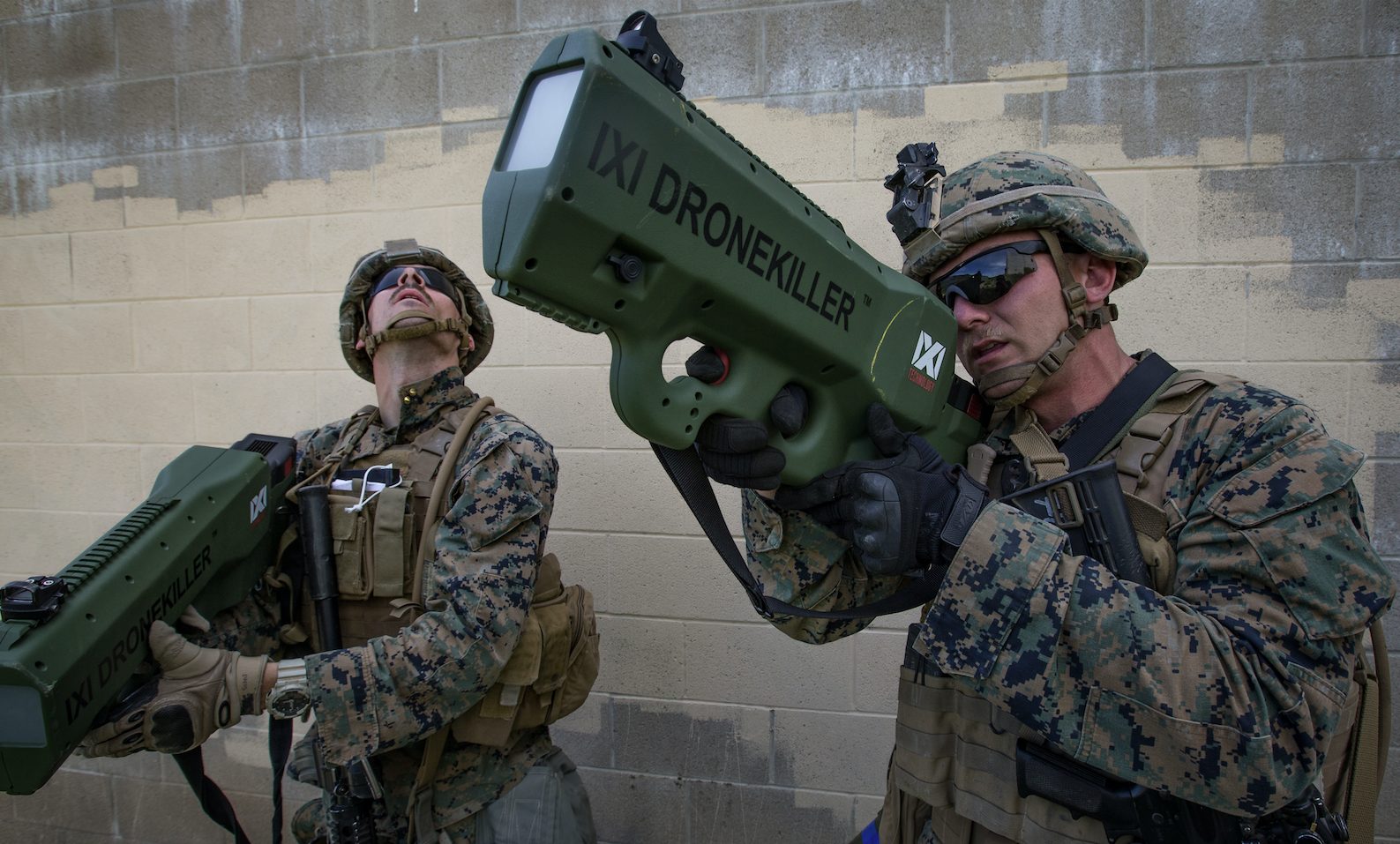
The Marines is a maritime land branch of the armed forces.
The Marines are ‘sisters’ to the Navy, both of which fall under the Department of the Navy.
Furthermore, the Marine Corps got its official start in 1834, but it dates back to the Revolutionary War when America needed to fight at sea and land.
Today, the Marines have operations on land and at sea, and they even have squadrons within the Navy.
What is the Marine Corps’ Responsibility?
The Marines are responsible for conducting warfare here and away from home, both on land and sea.
The Marines also work with other military branches to create a cohesive and cooperative response to any crisis.
Furthermore, the Marines have their own infantry, aerial operations, special operations, and artillery forces.
What is the Marine’s Mission?
The Marine’s mission is to protect and seizes naval bases during naval warfare.
The second part of the mission is to coordinate with other military branches to develop warfare techniques and equipment.
Lastly, the Marine Corps’ mission is to carry out orders from the President of the United States and the Department of Defense.
What is the size of the Marine Corps?
The Marines have approximately 177,000 active-duty service members and over 32,400 members in the reserve units.
Also, the Marines have over 1,200 aircraft.
How is the Marines Structured?
The Marines break into four separate groups.
First, there are the operating forces that handle all the combat.
Next, the headquarters for leadership, the supporting group that handles logistics, and finally, the Marine Corps Reserves.
The Marine Division has a Major General as a Commandant, who falls under the Secretary of the Navy and oversees the four Marines divisions.
Marine divisions are commanded by a Major General and consist of three regiments.
Next, the regiments have a Colonel commander, and the regiment consists of 3 battalions.
Battalions have a Lieutenant Colonel to command. Furthermore, it takes three companies to create a battalion.
Captains command a Marine company, which consists of three platoons.
Companies are at the lowest command level to still have a headquarters.
Platoons have a Lieutenant as a commander, and the platoon consists of 3 squads.
Squads have a Sergeant in command and consist of nine marines.
Lastly, there are three fire teams in a squad. A fire team is comprised of three marines and is led by a Corporal.
Related Article – Navy vs. Army
Navy vs. Marines: 5 Key Differences
Despite the Navy and Marines being a part of the Department of the Navy, they do have some differences.
Difference #1: Responsibilities
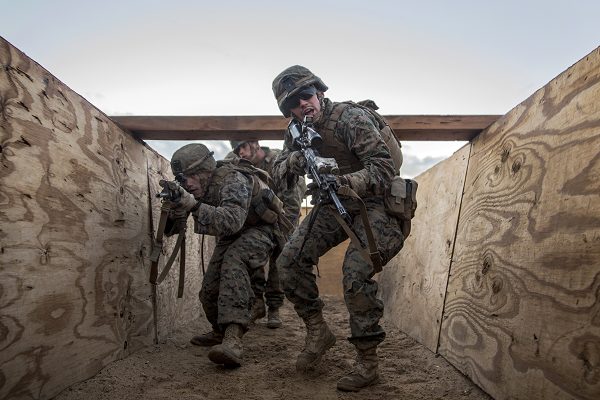
One notable difference between the Navy vs. Marines is the different responsibilities.
The Marines focus on battle and combat.
Also, the Marines seize and take over areas of conflict.
Furthermore, the Marines do ground combat, but they also have their own aviation section and offer support to other military branches.
On the other hand, the Navy makes sure the seas are safe.
Also, the Navy works to transport weapons and other resources.
Therefore, the Navy does not rely on hand-to-hand combat the way the Marines do.
Difference #2: Command
The command structures between the Navy vs. Marines are different.
The Navy has the administrative and operational sides, while the Marines have operations, leadership, logistics, and reserves.
Despite the differences in overall structure, the fact that there is a chain of command is the same for both branches.
For instance, a newly enlisted member in either branch is part of a smaller group or unit. There is a person in charge of each ever-widening group going up the chain of command.
Therefore, a service member would go to their immediate supervisor before going over their head to someone in charge further up the command chain.
Difference #3: Eligibility
When considering the Navy vs. Marines, you must consider eligibility.
To join the Navy, you must meet some eligibility requirements.
First, you must be a citizen of the United States or a legal resident.
Also, you must be between the ages of 17 and 41 to become an enlisted member. However, if you are 17, you need parental permission.
Furthermore, becoming a Navy officer means you must be between the ages of 19 and 32, up to 37 for prior enlisted, up to 58 for chaplains, and up to 64 for physicians.
If you wish to be an enlisted Navy member, you need a high school diploma or equivalent.
On the other hand, if you wish to be an officer, you need a four-year degree.
Also, all potential recruits must have a minimum passing score on their ASVAB test and pass the medical exam, which is done at the Military Entrance Processing Station (MEPS).
Lastly, you should be of good moral character.
When you compare the general requirements for the Marine Corps, you may notice they are similar.
The Marines’ age requirement for enlisted members is 17 to 28. For officers, the age restrictions are 20 to 28.
Furthermore, both branches include a minimum standard for the ASVAB test and have a medical screening at the MEPS center.
However, once you get closer to basic training, the Marines have a strength test before boot camp.
The Marine physical fitness tests include pull-ups or push-ups, planks, and a 3-mile timed run.
Related Article – Army Reserves Vs. National Guard
Difference #4: Promotions
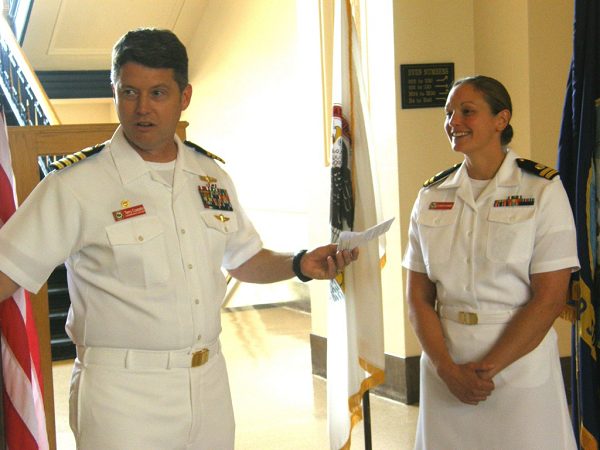
The Navy has two different promotion systems in place.
One system is for enlisted members, and the other is for officers.
The system depends partially on time spent in service to the Navy and the current pay grade for enlisted members.
Also, the staffing needs in the service members’ particular jobs impact promotions.
Promotions are automatic in the beginning, but eventually, the promotions become very competitive.
Officers also face competition as their rank increases.
Similarly, the Marines have both enlisted and officer promotion systems.
Also, the Marines have automatic promotions according to time in grade and time in service.
However, just like the Navy, the promotions for upper ranks become very competitive.
The Marines have a specific number of spots for ranks in each job. Marines must have a vacancy in a higher rank in their position.
Difference #5: Benefits
The Department of Defense handles the benefits for the branches of the military.
Therefore, most of the general benefits between the Navy vs. Marines are the same.
However, the Navy vs. Marines has different incentives for specific jobs or sign-up bonuses.
Those extra incentives depend on the Navy and the Marines’ current needs, in determining those additional bonuses and incentives.
Otherwise, you can expect access to educational, medical, housing, and all other benefits to be the same or similar.
Related Article – Army Vs. Air Force
Conclusion
Clearly, in the comparison between the Navy vs. Marines, there are similarities and differences.
The Navy and the Marines have different roles and responsibilities as well as missions.
However, since the Navy vs. Marines work so closely together, much of what they do overlaps as they support one another.
Furthermore, the branches have different command structures although the existence of the chain of command and how it is meant to be used is the same.
The eligibility to join is nearly the same as is the available benefits.
Resources:
- Replacing Dog Tags: 6 Things You Need to Know - June 28, 2024
- Navy OAR Test Study Guide - June 24, 2024
- 10 Best Sniper Movies of all Time - June 20, 2024
Originally posted on March 11, 2021 @ 3:22 pm
Affiliate Disclosure: This post may contain affiliate links. If you click and purchase, I may receive a small commission at no extra cost to you. I only recommend products I have personally vetted. Learn more.
